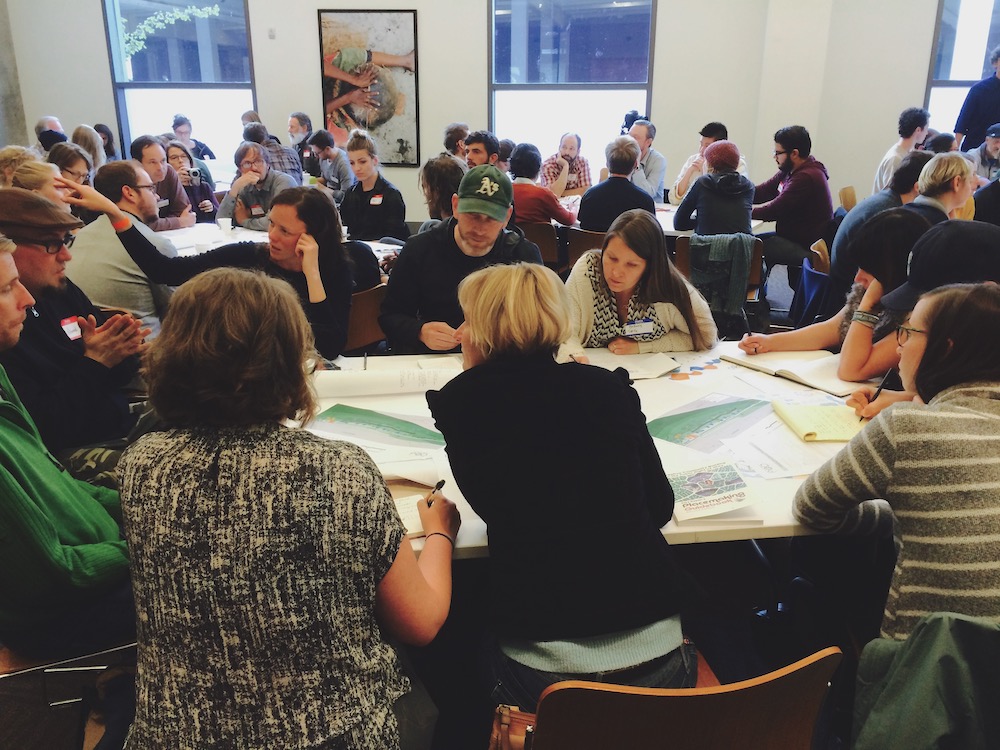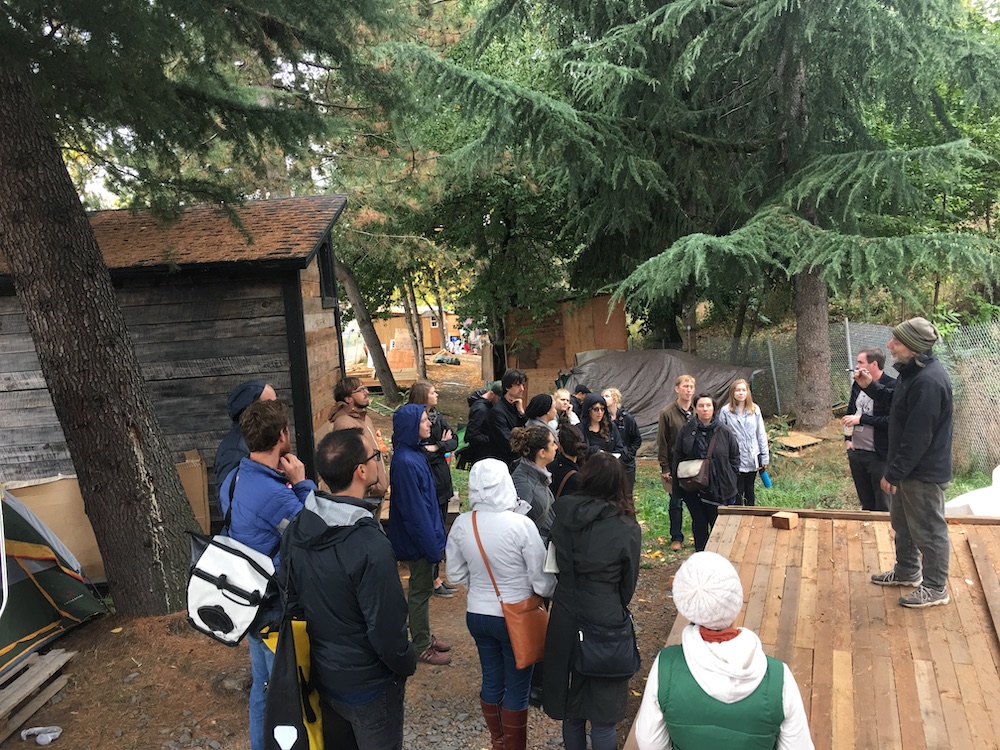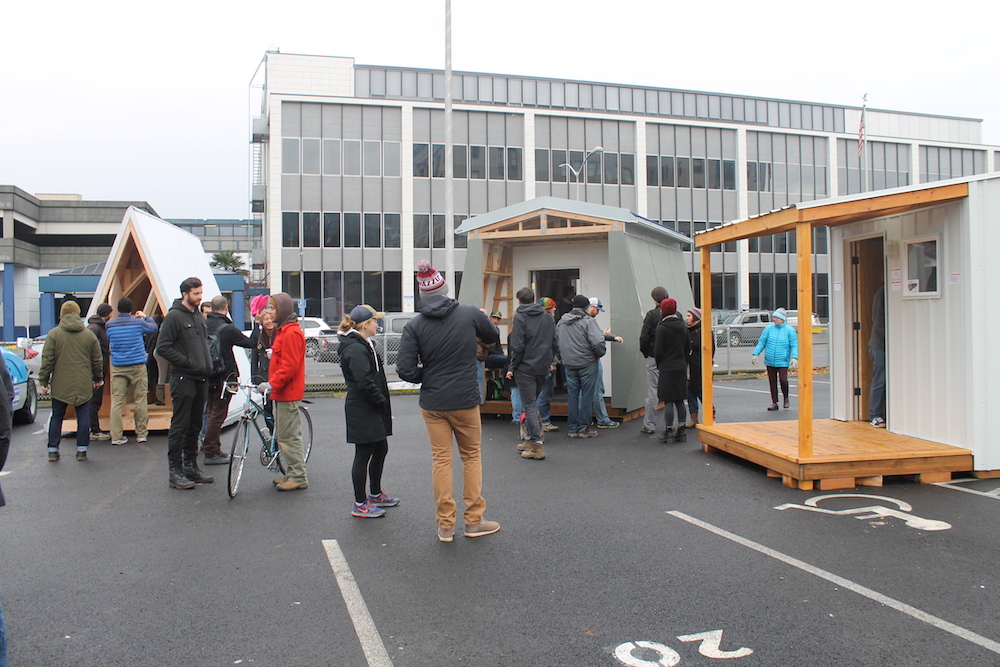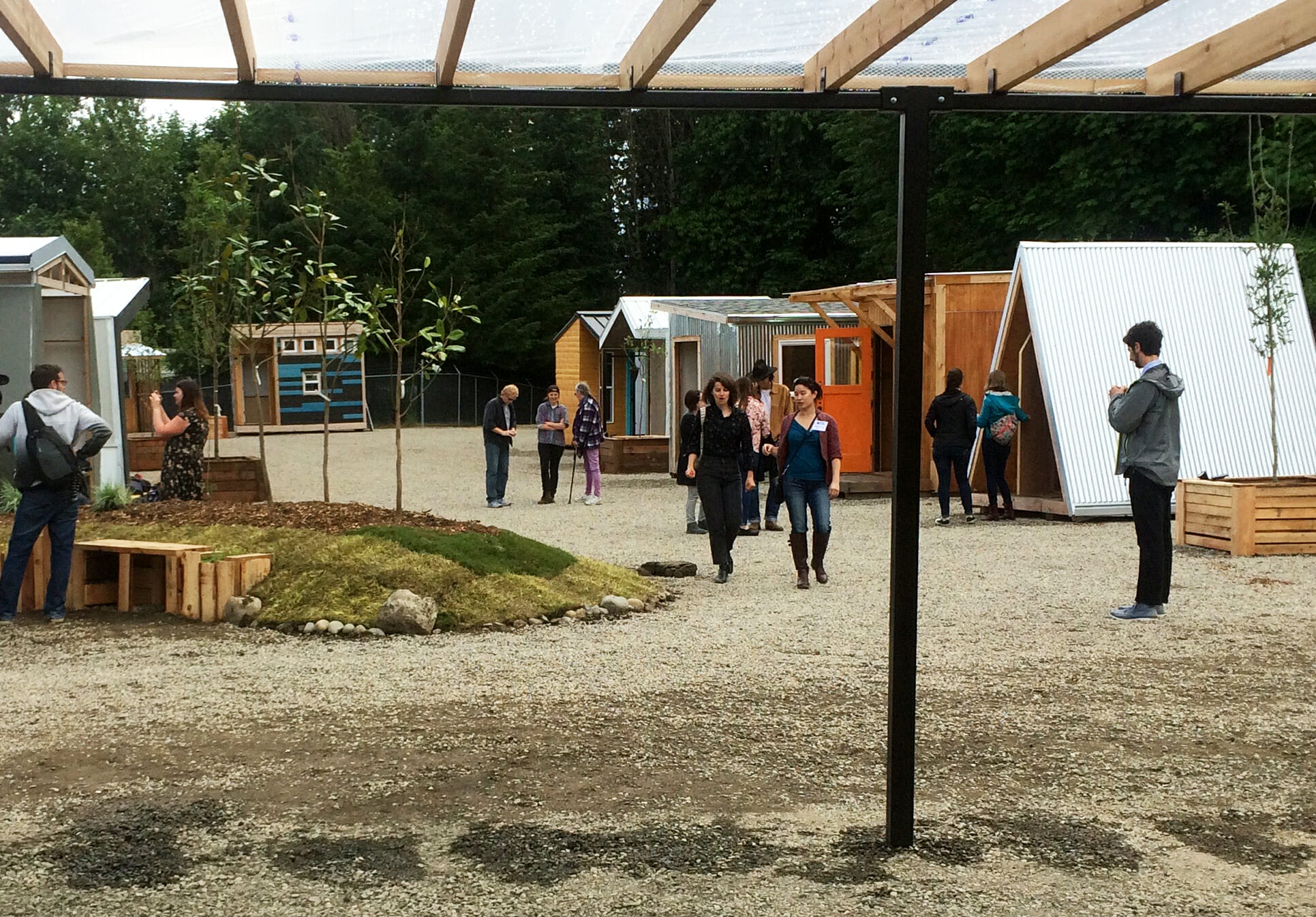From Pod to Place
Village-Making Through Participatory Design
Todd Ferry guided students in the process of building a neighborhood of homes for some of Portland’s houseless community.
Images Courtesy of Mark Stein and NashCO. Photography

By Todd Ferry, Associate Director & Senior Research Associate, Center for Public Interest Design, Portland State University
I arrived at the Kenton Women’s Village for its official opening. For the first time in a long while there was nothing to be done; no housing to build, no students to lead, no decisions to make, and no trees to plant. The project would inevitably and necessarily evolve with time, but my part was complete. I glanced at the clusters of people peppered throughout the village and could hardly believe that the majority of these people who had recently become such close and valued collaborators were strangers just a year ago. In that short time, we had formed an incredible coalition and utilized an inclusive design process to address houselessness — it resulted in policy changes, new models for serving Portlanders, and a built pilot project to house 14 previously houseless women.
With a moment to finally pause and reflect, the question that came to mind was, how did we pull this off? With a moment to finally pause and reflect, the question that came to mind was, how did we pull this off? Of course, I know how we “pulled it off” and still had the sunburn, text message chains, and coffee receipts as reminders. After four years with the Center for Public Interest Design (CPID), it should no longer come as a surprise.
The CPID is a research, education, and design center that uses the power of design to address the needs of traditionally underserved populations worldwide. Recent projects at the CPID include a sustainable community center in Inner Mongolia, a mobile stage for the Portland Opera to bring opera and the arts to more communities, and resiliency planning and building efforts on the Northern Cheyenne reservation in Southeastern Montana, just to name just a few. In each case, the team of students, faculty, and community collaborators managed to accomplish an incredible amount in a short period of time. But the Kenton Women’s Village project feels distinct somehow. Perhaps it is because it happened so quickly, or maybe it is the sheer number of project participants, which is easily in the hundreds. In any case, it is a potent reminder of the incredible power of participatory design to address difficult social problems like houselessness.
In the fall of 2015 the City of Portland declared a state of emergency on homelessness due to a shortage of affordable housing and an increase in the number of unsheltered individuals and families. A point-in-time report from that year identified over 3,800 houseless Portlanders on any given night. Using an expanded definition of homelessness, to include those “doubled-up” in insecure and inadequate housing due to financial circumstances, increased the number to over 16,000.
In the spring of 2016 there still were few reasons for hope, with the exception of intentional communities — or villages — that the houseless were making to support themselves. Housing advocates, activists, and people with houseless experience formed a group called the Village Coalition in order to help support these villages and promote the village model as a potential solution to houselessness. After several Village Coalition meetings, and visits to existing villages, it became clear that: a) self-governed villages were having great success in providing safe spaces in supportive communities but needed help with physical infrastructure; b) design had a significant role to play to aid in these efforts, but simply handing over designs for tiny houses would be insufficient; and c) initiatives to change perceptions about houselessness in Portland would be essential for successfully integrating a village into the urban fabric.
Two villages had been operating in Portland for several years without the help of the government, and a third, Hazelnut Grove, had recently formed and been granted temporary use of a wooded swath of land along Interstate Avenue. There, some of the approximately 18 residents had already begun working together to build small wooden shelters around their tents — without city approval — and constructed a shared kitchen which served as the heart of the community. From its beginning, Hazelnut Grove demonstrated a vibrancy and inspiring sense of community that is rarely found elsewhere today (including traditional neighborhoods), which is perhaps part of why it attracted such strong advocates and was not immediately “swept” like many other nascent villages.
Residents of Hazelnut Grove approached us at CPID to develop plans for tiny houses and we began talking with other designers involved in the Village Coalition. Together we decided to pose a challenge to the larger architecture community. The CPID and partners at City Repair, Communitecture, and Open Architecture formed the Partners On Dwelling Initiative (POD) to launch a call for design solutions that could support an engaged houseless population.
On October 1, 2016, the POD Initiative organizers held an open charrette at Mercy Corps in downtown Portland that brought together architects with houseless individuals to explore how thoughtful design could support the village model. Over 100 people attended and after hearing from a range of speakers, including residents of Hazelnut Grove, teams were formed and tasked with designing micro-dwelling units called “sleeping pods” that together could form a village complete with shared cooking, bathing, and gathering facilities.
The term “pod” allowed designers to avoid expectations and requirements associated with established building forms like “tiny houses.” New design parameters were established: each pod had to be fully insulated, have lockable doors and operable windows, and be easily transportable with a forklift and flatbed truck. The minimum allowable footprint would be 6’x 8’ with a maximum footprint of 8’x 12’, with a maximum height of 10’6”, in order to fit under bridges.
By the end of the design charrette a wide range of ideas emerged — 14 teams agreed to submit designs and build their pod in space made available by the POD Initiative organizers, aided by funds for materials. At the time of the charrette, however, the project had no funding, no clear political support, no place to construct the pods, and no site for them to form a village once they were built.
Fortunately, then-mayor Charlie Hales had attended the charrette. He was inspired by the architecture community’s willingness to explore innovative solutions to houselssness, and agreed to provide $2,000 for materials for each pod. While it was modest funding, this was a crucial step — it marks the beginning of the city investing in the village model.
After finding a suitable building site for the pods, the design teams spent several weeks in November and December working side-by-side in Portland’s oldest warehouse. Despite the bitter cold, spirits were high — passing around Thanksgiving leftovers through the scaffolds of a dozen newly-framed structures over the holiday weekend will remain particularly memorable. The teams consisted of many of Portland’s leading architecture firms: Holst, SRG, SERA, and LRS, to name a few, as well as two teams from PSU, which included my architecture students, in their penultimate undergraduate design studio, and a group led by the CPID Student Fellows.



The pods were finished on December 9th and transported — not without difficulty — to a site in downtown Portland next to the Pacific Northwest College of Art, where they remained on display for several weeks. Portlanders from around the city were invited to visit and enter the pods, attend panel discussions on houselessness, experience the village model, and learn what it might mean to have a village in their neighborhood.
We identified a site in the Kenton neighborhood in North Portland to form a village from the newly built pods. The one-acre site was on an industrial lot, but directly adjacent to a residential area and neighborhood park — it was also within walking distance to light rail and multiple bus stops.
Pieces began falling into place and a potential site for a new village was identified. While the City of Portland could have moved the pods to the site immediately, the project partners agreed that it was important to work with residents of the Kenton neighborhood to ensure the village would be a welcome part of the community. In fact, we promised to meet with stakeholders in Kenton regularly until they were ready to take a vote on whether or not to allow the village into their neighborhood, and their decision would be respected. Over several months, the project partners worked with members of the Kenton Neighborhood Association to develop the village. The City-sponsored village would be proposed as a community of all women, operated by Catholic Charities, supported by the Village Coalition, and designed by the Center for Public Interest Design. CPID Director Sergio Palleroni and I worked with students in a graduate architecture studio on the design of the village, hosting community charrettes and workshops in Kenton — we also gathered feedback from partners in the houseless community, including our expert advisors on village-making at Hazelnut Grove.

On March 8th, over 300 people filled a small room where the neighborhood would cast their ballots to discuss the proposal. There were several speakers from the City of Portland and the partner organizations, but the most moving speeches, by far, came from neighborhood residents that had been involved in the village design process. Each one spoke of going from skeptic to enthusiastic advocate as they learned about houselessness, about the village model, and as they participated in the co-creation of the village design itself. In the end, Kenton decided to welcome the village into their neighborhood in a decisive vote of over 2-to-1. We all breathed a massive sigh of relief and then got to work creating the village.
When I arrived on site for the opening on June 9th, 2017, the village was complete. The site had been bustling with dozens of PSU students, volunteers, and Kenton neighbors for the previous 10 days as we worked on placemaking efforts to prepare the site for its 14 new residents, and it was hard to shake the feeling that I should still be doing something. But the project was ready. We had co-created a village that serves as a model for the City of Portland to replicate, a coalition was formed that values the importance of a thoughtful process in creating change, and, most importantly, 14 previously unhoused people now had a safe place to call home.
Our design charrette was on October 1st and we opened the village on June 9th, an incredibly fast turnaround for a project dealing with such a politically-charged social issue. The speed of the process was proportionate to the urgency of the crisis. Together we showed that a village — one of many models needed to address houselessness — could be done quickly, affordably, and beautifully.
It is easy to feel overwhelmed when confronting a massive issue like houselessness — but identifying the smallest unit of a given problem can often provide an entry point for people to take immediate action while working toward larger systemic change. In our case, that unit was the pod. Individually each component is important, but together they form something that’s greater than the sum of its parts, in our case, a village.
Design is an iterative process, and the Kenton Women’s Village is just the first of many villages in Portland. With an incredible coalition of partners, we’re looking forward to the next two villages, envisioned and built through inclusive and participatory design practices to serve the whole community.

From Design Museum Magazine Issue 005
DEFINE
Houseless
The term houseless is used in place of homeless, as it is preferred by our project partners as a more respectful term that both acknowledges that home can be a community, neighborhood, city, etc., and more directly addresses what the need is: housing. The terms homeless and homelessness are used when referencing policies or organizations that use this term.
